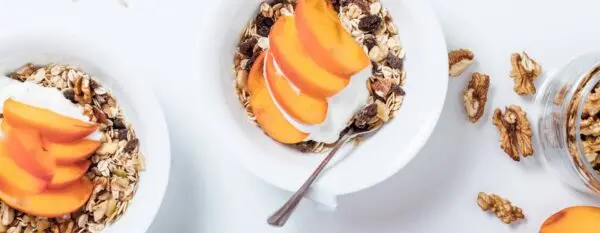What is fiber?
Dietary fiber is a non-digestible carbohydrate found in plants. Dietary fibers include cellulose, hemicellulose, pectin, lignin, gums, B-glucans, and fructans. The amount of fiber in a particular plant depends on which part you eat (leaf, root, stem), and the plant’s maturity. A good portion of fiber is found in the cell wall of plants which is why it is recommended to eat the skin of fruits and vegetables whenever possible. Dietary fiber benefits those suffering from GI disorders, unstable blood sugar levels, and more.
What foods contain fiber?
Good food sources of fiber include fruits, vegetables, whole grains, legumes, nuts, and seeds. Legumes that are high in fiber include split peas (16.3g), lentils (15.6g), and beans, especially black beans (15g) and lima beans (13.2g) per one cup.
It is important to note that juicing fruits and vegetables removes all the fiber from them – and all dietary fiber benefits along with it. So, drinking a glass of freshly squeezed juice is not the same as eating a whole piece of fruit. In addition, many processed grains such as white breads and pastas are low in fiber. It’s recommended to choose whole grains over processed grains whenever possible.
Types of dietary fiber
Dietary fiber can be classified as either water soluble or insoluble.
Water soluble fiber: some hemicelluloses, pectin, gums, B-glucans, and fructan
Water soluble fibers are effective in reducing serum cholesterol (or total blood cholesterol which includes HDL, LDL, and triglycerides) and postprandial blood glucose levels (glucose levels in the blood after a meal).
Good sources: oats, peas, barley, legumes, apples, strawberries, citrus, and bran. Fructans are specifically found in asparagus, artichokes, onions, garlic, tomatoes, and bananas.
Water insoluble fiber: Cellulose, some hemicelluloses, lignin
Water insoluble fibers are effective in preventing constipation by making solid waste bulkier. They also help treat certain gastrointestinal disorders.
Good sources: bran, wheat grains, legumes, nuts, roots vegetables, cabbage
Functions of fiber
- Solubility in water
Fiber cannot be digested or absorbed because humans lack the enzyme that is necessary to break down fiber into glucose. The term soluble and insoluble simply refer to their ability to dissolve in water, not their ability to be digested/absorbed.
Soluble fiber: dissolves in hot water
- Delays gastric emptying
- Increases transit time (time required for food to pass through your intestines) i.e. slower movement of food)
- Decreases nutrient (glucose) absorption
Insoluble fiber: does not dissolve in hot water
- Decreases transit time (speed up movement of food)
- Makes solid waste bulkier
- Water holding capacity
A good way to think of fiber is as a sponge that is able to soak up water. Fiber from food binds to water as it moves through the digestive tract which allows for two things:
- Delays gastric emptying: Gastric emptying is the time it takes food to empty from the stomach to the small intestine. This provides satiety because nutrients are able to stay in the stomach longer with fiber making you feel fuller for longer
- Decreases nutrient diffusion rate: Delays glucose absorption, lowers blood glucose concentrations, and affects insulin response. This is especially beneficial for people with type two diabetes to reduce post-prandial blood glucose concentrations and insulin response.
- Absorption or binding ability
Consumption of fiber allows for:
- Reduced absorption of fats
- Lowered serum cholesterol concentration
- Degradability/fermentability
An important function of fiber is that it acts as a prebiotic that helps keep our gut healthy. The community of bacteria that are living in your gut help you digest your food, and is known as a microbiome. There are two ways to keep this microbiome healthy: probiotics (live organisms that add to the bacteria population in your gut) and prebiotics (feeding the bacteria that is already present in the gut to continue to grow and be healthy). The prebiotics in fibrous foods literally are the food your gut microbiome needs.So even though fiber evades digestion in the stomach, it can be fermented in the intestines by bacteria in our microbiome. The end result of the fermentation of dietary fibers is short chain fatty acids (SCFA).
- What is the role of short chain fatty acids?
- Decreases the pH of the intestine. This is important for a number of reasons, most notably it decreases the amount of secondary bile acids that are produced (which are more harmful compared to primary bile acids), or promotes their excretion
- Helps create, grow, and maintain cells in the intestine
- Increases water and sodium absorption in the intestine
- Improves blood flow to abdominal organs. This enhances the transport of nutrients.
- Provides energy
- What is the role of short chain fatty acids?
Dietary fiber benefits
Not only does fiber normalize bowel movements and provide satiety (feeling fuller longer), it also has been shown to play a role in disease prevention and management.Fiber plays a role in:
Dietary fiber benefit #1: Protection against cardiovascular disease: Soluble fibers can lower serum cholesterol levels.
Dietary fiber benefit #2: Treats GI disorders: Insoluble fibers are used to treat gallstones, IBS, and constipation.
Dietary fiber benefit #3: Helps in weight control: Fiber intake helps with weight control because it provides satiety and may reduce hunger.
Dietary fiber benefit #4: Helps in controlling blood sugar levels: Soluble fiber in particular can slow the absorption of sugar and help improve blood sugar levels. This is especially important for people with Type 2 diabetes.
How much fiber should I eat?
It is recommended that healthy adult women get 25g/day and men get 38g/day. However about 95% of Americans do not reach this recommendation. How can you make sure you are getting enough fiber?
Easy ways to add more fiber to your diet
- Focus on whole grains: Aim to consume 2-3 servings of grains per day with at least half your grains as whole grains. A simple example of how you can derive the benefits of dietary fiber would be replacing white rice with brown rice, or white bread with whole grain bread. Substitute all purpose flour for whole-wheat flour when baking. When looking for breakfast cereals, look for high-fiber options (5 or more grams of fiber per serving) with the “whole grain” seal on the box.
- Befriend beans: Legumes, such as beans, peas, and lentils are excellent sources of fiber that are easy to turn into dips, soups, curries, and other flavorful dishes.
- 5 A Day: This fruit and vegetable guide is an easy reminder to aim to consume at least 5 servings of fruits and vegetables per day.
When you are beginning to add more fiber to your diet it is important to introduce those foods slowly. Adding too much fiber too quickly can lead to intestinal gas, abdominal bloating and cramping. Increasing your fiber intake gradually over a few weeks allows your digestive system time to adjust to the change. It is also important to stay hydrated with plenty of water. Fiber works best when it absorbs water.
But just like any nutrient, you can consume too much. Eating too much fiber can result in bloating, gas, stomach cramps, and diarrhea. Following the three easy guidelines above will help ensure an adequate amount of fiber.
Important Take-away
Fiber is a non-digestible carbohydrate found in plants. There are two kinds of dietary fiber, water soluble fiber and water insoluble fiber. Soluble fiber binds to water as it moves through the digestive tract allowing you stay fuller for longer and positively affects cholesterol and blood glucose. Insoluble fiber helps keep you regular by making solid waste bulkier. Fiber is also an important prebiotic that helps keep your gut healthy. Bacteria in the gut ferment fiber into short-chain fatty acids that have a number of physiological effects on the body.
Dietary fiber benefits have been shown to include assistance in dealing with a number of different conditions including cardiovascular disease, diabetes, gastrointestinal disorders, and weight control. Fruits, vegetables, whole grains, legumes, nuts, and seeds are excellent sources of fiber. To ensure an adequate amount of fiber in your diet women should consume 25g/day and men should consume 38g/day. Increasing fiber intake should happen gradually to allow your body time to adjust.
As always individual fiber needs differ from person to person. If you have questions or concerns about your specific dietary needs schedule and appointment with one of our dietitians.
To learn more about dietary fiber benefits and what the best way to incorporate fiber into your diet is, you can talk to a Health Loft dietitian in Chicago, IL in person or online across the United States by calling us at (312) 374-5399 or by scheduling an appointment online.
References
- https://www.mayoclinic.org/healthy-lifestyle/nutrition-and-healthy-eating/in-depth/fiber/art-20043983
- https://www.mayoclinic.org/prebiotics-probiotics-and-your-health/art-20390058
- https://www.eatright.org/food/vitamins-and-supplements/nutrient-rich-foods/fiber
- https://www.ncbi.nlm.nih.gov/pmc/articles/PMC6124841/
- https://www.ncbi.nlm.nih.gov/pmc/articles/PMC3735932/
- https://www.ncbi.nlm.nih.gov/pmc/articles/PMC3649719/
- Advanced Nutrition and Human Metabolism By: SareenS. Gropper, Jack L. Smith, and James L. Groff.
- Lyles, Renea. “Seasonal Fruits and Vegetables.” Nutrition Science II, 2019, University of Illinois at Chicago, Applied Health Science Building, Chicago, IL. Lecture.
- Song, Zhenyuan. “Fiber.” Nutrition Science I, 2019, University of Illinois at Chicago, Applied Health Science Building, Chicago, IL. Lecture.
Written by Erica Drost
Edited by Alexander Franz
Reviewed by Morgan Murdock, RD.


